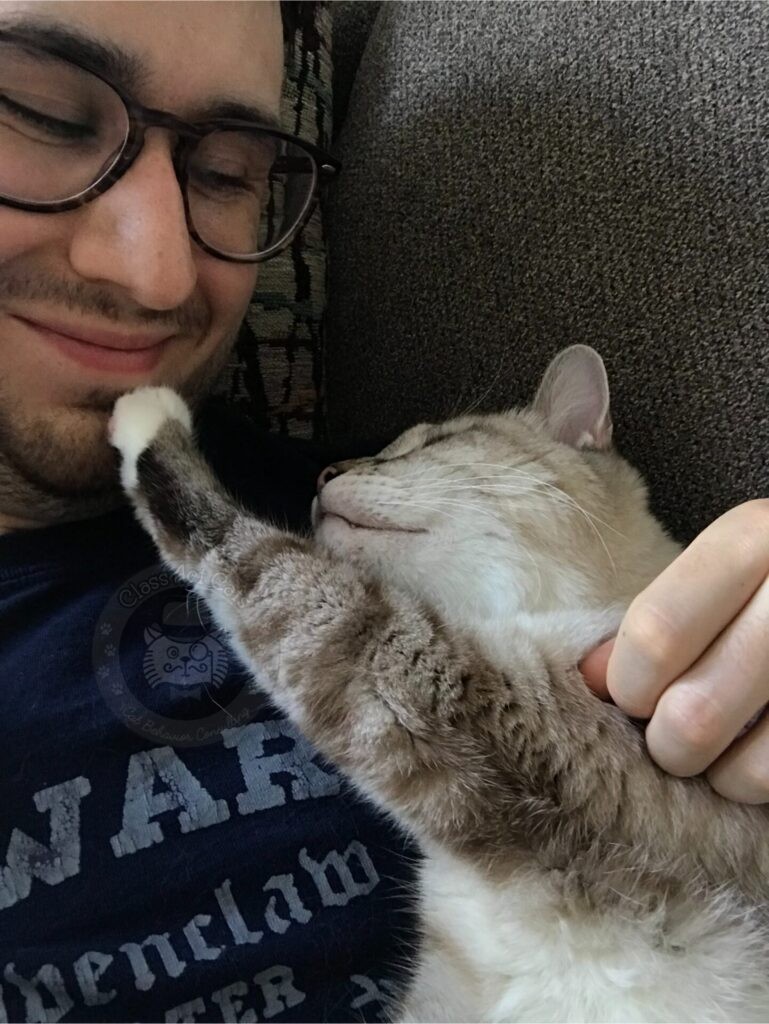Have you ever seen an adorable cat and felt an immediate urge to reach out and pet them? It’s a natural instinct for many cat lovers! As someone who spends my days helping people understand their feline friends, I often have to resist this impulse. While petting a cat can be a wonderful bonding experience, it’s crucial to recognize that sometimes, despite how much we want to pet them, the cat might not be in the mood. But how can you tell if a cat is actually inviting you to pet them? Fortunately, cats are quite communicative if you know what signals to look for. Understanding these cues is key to positive interactions and building trust with your feline companion.
Understanding Cat Sociability: Reading the Signs for “Pet Me”
When a cat is receptive to being petted, they will typically exhibit body language that signals they are feeling comfortable, confident, and secure in your presence. These behaviors are your cat’s way of saying, “I’m friendly, and I might be open to some interaction!” Learning to recognize these signs is the first step in understanding when your cat is giving you the green light for petting.
Here are some common behaviors that suggest a cat is feeling sociable and potentially wants to be petted:
-
Approaching with an Upright Tail with a Curved Tip: A tail held high like a question mark is often a friendly greeting. This “question mark” tail, especially with a gentle curve at the tip, indicates happiness and an invitation for interaction.
-
Bunting (Affectionate Head Butting): When a cat gently rubs their head or cheeks against you, this is called bunting. This behavior is a strong sign of affection and trust. They are marking you with their scent and often seeking attention and interaction, which can include petting.
-
Slow Blinking: If a cat looks at you and slowly blinks, this is often referred to as a “cat kiss.” It’s a non-threatening gesture that signifies trust and comfort. Reciprocating with a slow blink back can be a lovely way to communicate with your cat.
-
Following You Around or Lounging Nearby: A cat that chooses to be in your vicinity, whether following you from room to room or simply relaxing close to you, is showing that they enjoy your company. This proximity can often be an invitation for interaction, including gentle petting.
-
Purring: While purring can sometimes indicate stress or pain, in a relaxed and comfortable context, purring is usually a sign of contentment. If a cat is purring while exhibiting other friendly behaviors, it’s a good indication they are enjoying the interaction and might welcome petting.
-
Rubbing Against Your Legs: Similar to bunting, rubbing against your legs is a way for cats to mark you with their scent and show affection. It’s a clear sign they are comfortable around you and are seeking attention.
-
Wrapping Their Tail Around You: This is a more intimate gesture, often seen as a feline hug. Wrapping a tail around your leg or arm indicates a strong bond and a high level of comfort and affection.
This list provides a solid foundation for understanding feline sociability. To delve deeper into the fascinating world of cat body language, “Kitty Language” by Lili Chin is an excellent resource. This book uses clear illustrations and easy-to-understand explanations to help you decode what your cat is trying to tell you.
Friendly Overtures vs. A Desire to Be Petted: It’s Not Always the Same Thing
It’s important to remember that even if a cat is displaying friendly behaviors, it doesn’t automatically mean they want to be petted at that moment. Cats are complex creatures with their own preferences and boundaries. Just like people, their desire for physical touch can vary.
For instance, during colder months, you might find your cat seeking warmth by curling up on your lap more frequently. While they clearly enjoy being close to you, petting might not always be welcome. You might offer a gentle stroke, and they might respond with a subtle “bite gesture” – turning their head towards your hand with their teeth showing, even without applying pressure. This is a polite way of saying, “I appreciate you letting me sit here, but I’m not in the mood for petting right now.” Some cats might be even more subtle, simply pushing your hand away.
Why would a cat choose to sit on your lap if they don’t want to be petted? There could be many reasons. Perhaps they are seeking your body heat, or they simply enjoy being near you without wanting physical interaction. Think of it this way: you likely have friends you enjoy spending time with and would invite into your home, but you might not want a hug from them every time you meet. Cats are similar. They can enjoy your company and presence without always wanting to be petted. They might also initially be receptive to petting but then change their minds mid-interaction.
This brings us to the crucial concept of consent when interacting with animals. While it’s not always discussed, respecting a cat’s consent is vital for their well-being and for building a positive relationship with them. Prioritizing consent isn’t just about ethics and cat welfare; it also benefits you by preventing unwanted scratches or bites.
The Consent Test: Politely Asking “May I Pet You?”
So, how do you navigate this and respectfully determine if your cat wants to be petted? The answer lies in something called a “consent test.” It sounds formal, but it’s a simple and effective way to ask your cat for permission before initiating petting. This approach strengthens your bond and ensures your cat feels safe and respected.
Here’s how to perform a consent test:
- Offer your hand: Extend your hand slowly towards your cat, but not directly at them. Keep your hand a short distance away from their body.
- Let them sniff: Allow your cat to approach your hand and sniff it. This gives them a chance to gather information about you through scent.
- Wait for initiation: This is the most crucial step. Instead of immediately petting your cat after they sniff your hand, wait to see if they initiate further contact. Do they rub their cheek against your hand? Do they lean into your touch? These are signs of initiation.
- Pet gently where they initiate: If your cat initiates contact, you can proceed to pet them gently in the area where they rubbed or leaned. Cats often enjoy being petted around their cheeks, chin, and the base of their ears. These areas have scent glands, and petting here can be particularly rewarding for them.
After a few pets, pause and “ask” again. Briefly remove your hand. If your cat wants more petting, they will likely re-initiate contact by rubbing against your hand or nudging you for attention. If they don’t re-initiate, respect their decision and give them space. They might be done with petting for now, and that’s perfectly okay! Ignoring their cues and continuing to pet when they’ve indicated they’re finished can lead to unwanted behaviors like biting.
Avoiding a Common Mistake: Sniffing Isn’t Consent
A frequent mistake people make is to misinterpret a cat sniffing their hand as an invitation to pet them immediately. While allowing your cat to sniff your hand is part of the consent test, it’s not the same as them initiating contact to be petted. Sniffing is simply a cat gathering information. You need to wait for them to take the next step and actively seek petting by rubbing or leaning into your hand. Remember, the key is to wait for the cat to initiate the contact for petting, not just to sniff you.
What If Your Cat Doesn’t Enjoy Being Petted?
It’s important to acknowledge that some cats simply don’t enjoy being petted as much as others, or perhaps rarely want to be petted at all. Shy cats, in particular, might prefer less physical interaction and may express affection in different ways. This is perfectly normal, and there’s absolutely nothing “wrong” with a cat who isn’t overly cuddly. It certainly doesn’t mean your cat dislikes you! They might show their affection through other means, such as playing with you or simply being present in the same room.
One of my own cats, Prozac, wasn’t initially a big fan of snuggling. When I first brought him home, he was more interested in playing. I built our bond by engaging in playtime with his favorite toys and offering occasional gentle scratches on his terms when he seemed receptive. We also engaged in training sessions, which helped us communicate and connect in a different way. I cherished our relationship, even though cuddles weren’t his primary love language at the time.
However, things can change over time when you respect a cat’s boundaries and preferences. By giving Prozac control over interactions and honoring his space, he gradually became more comfortable with physical affection.
Ultimately, respecting your cat’s wishes regarding petting is beneficial for both of you. While it might be disappointing if your cat declines petting, honoring their boundaries strengthens your relationship and prevents potential negative interactions like bites or scratches. By learning to read your cat’s cues and practicing consent, you can create a more harmonious and loving bond with your feline companion.
Need Deeper Insights into Your Cat’s Behavior?
If you’re looking for personalized guidance in understanding your cat’s unique behavior and strengthening your communication, consider scheduling a consultation with a cat behavior expert. Set Up a Consultation to gain tailored advice and build an even stronger bond with your cat.

